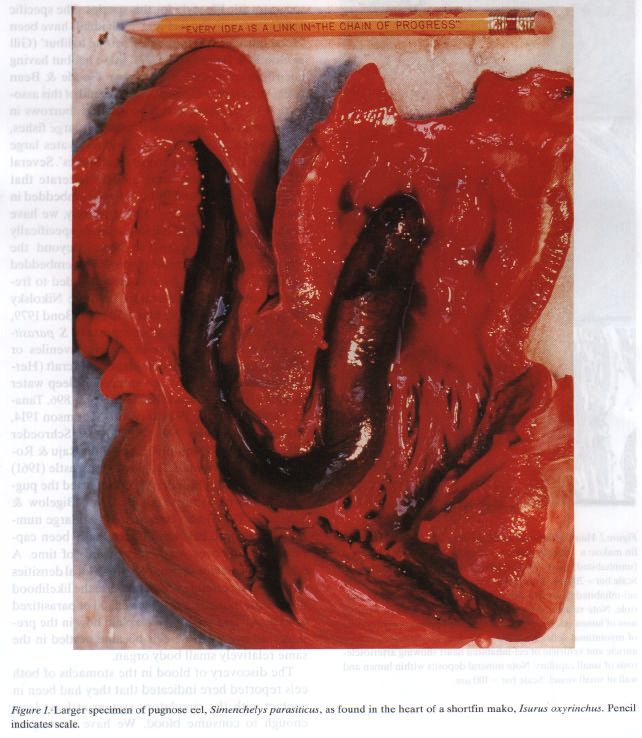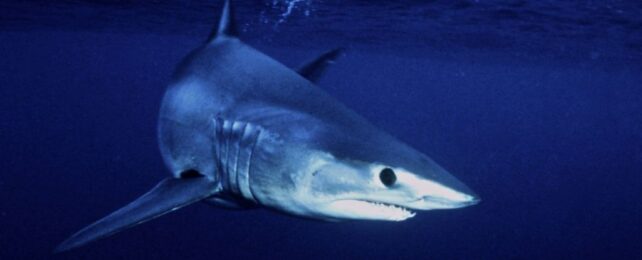When you think of parasites, you probably think of worms and bugs… but in the brutal realm of the ocean, it seems that anything goes.
Not even sharks are safe there, and some rare cases prove just how harsh life below the waves can get. In the hearts and organs of sharks, scientists have occasionally recorded a rare, but nevertheless possible, parasite: the snubnosed eel (Simenchelys parasitica).
In one case, recorded in 1997, a large shortfin mako shark (Isurus oxyrinchus) was cut open to reveal two eels nestled into the shark's heart and glutted with shark blood. Ten years later, in 2007, snubnosed eels were found in the heart, body cavity, and muscles of a smalltooth sand tiger (Odontaspis ferox).
What makes these cases interesting is that the eels – the only species of their genus – don't need to be parasites. They can live quite happily out in the ocean, just eeling about, scavenging the dead remains of marine animals on the seafloor.

But no. Snubnosed eels also like burrowing their way into the flesh of larger fish, just for the halibut, where they wallow and feast to their little hearts' content.
The eel was not known to parasitize sharks until a male shortfin mako shark was recovered from the western North Atlantic seafloor in June 1992 and brought to land at Montauk, New York.
The shark was a large one, tipping the scales at 395 kilograms; it was foul-hooked on a longline, which means the hook had caught it somewhere other than its mouth, and it was already dead when it was brought aboard.
Discoloration suggested that the shark had been on the muddy seafloor for some time. It was placed in a cold room until the next day so that it could be carefully studied to determine how it had died – disease, for instance, or parasites.
The next day, when the shark was cut open by biologists Janine Caira of the University of Connecticut and Nancy Kohler of the Northeast Fisheries Science Center, there was a surprise inside, like some sort of ghastly Kinder egg.
There, nestled in the lumen of the shark's heart, were two plump and glistening juvenile female snubnosed eels, measuring 21 and 24 centimeters (8.3 and 9.4 inches) in length, respectively.
They were dead, of course; they'd been fished out of the ocean and put in cold storage. But they appeared to have been healthy before that. Moreover, there was evidence that the eels had been merrily ensconced in the shark's heart for some time.
"The stomachs of both eels were filled with blood, suggesting that they had been within the shark at least long enough to feed," wrote a team led by Caira in a paper published in 1997. "Stomach contents of both eels consisted entirely of clotted blood. No intestinal contents (food or parasites) were found in either eel."
There was other evidence of their stay. There was damage to the shark's heart that was not present in the hearts of six other, eel-free shortfin mako sharks the researchers examined. But, interestingly, the scientists couldn't find signs of how the eels got from outside the shark to inside its heart.
The team believes that what may have happened is that the eels found the shark injured or dead by the longline hook and took the opportunity to feast.
"Having been compromised by being hooked, the shortfin mako dangled from the capture line on or just above the ocean bottom about the time of its death," they wrote in their paper.
"Either just prior to or after its death, the two pugnose eels located the shark and burrowed into it in the same general area somewhere about the gills or throat. The eels entered the circulatory system (either via an afferent artery or the ventral aorta) and traveled into the heart. At some time during this process, the eels consumed blood."
We know even less about the sand tiger. Scant details of its case were shared in a 2007 paper about the shark's population range and density: a female shark, 3.7 meters (12.1 feet) in length, was found drifting in the ocean, dead, near Fuerteventura in the Canary Islands. Several snubnosed eels were found "within the heart, body cavity, and adjacent dorsal musculature" of the shark.
"This shark was presumably adult, but its ovaries were entirely missing, either having been consumed by the eels or having naturally degenerated," wrote a team led by shark biologist Ian Fergusson, who is also a meteorologist with the BBC in the UK.
"It is possible that the eels were contributory to the cause of death as no other obvious external or internal causal factors were found."
Two instances are not a trend, and the eels seem to thrive on food sources that aren't living. On a whale carcass observed off the coast of Japan, for instance, snubnosed eels constituted more than half the total observations of animals coming to feed. The video up above shows how they do it. But it might be worth studying this deep-sea bottom feeder more closely.
At the moment, its current strategy is what is known as facultative parasitism; the eels don't need to feed on living animals. But the ability to do so could be analogous to how other organisms evolved obligate parasitism or the absolute need to glom onto another living organism for survival.
As Caira and her colleagues note, "This ability to live even briefly within another organism has important potential evolutionary significance as it provides future opportunity for phylogenetic and ecological changes which could eventually produce obligate parasite lineages and true hosts."
The paper, published in 1997, appeared in Environmental Biology of Fishes.
